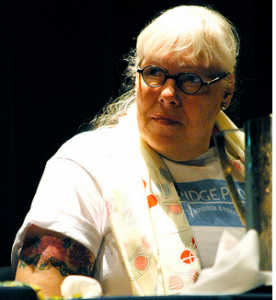Who really was Alice Paul?
This is the question that Zoe Nicholson, satyagrahi, feminist, scholar, and lifelong activist, spent over forty years  researching and synthesizing to realize the woman from the sensationalized myth of a woman we have been taught about in school or that has been depicted in film. Through her research Nicholson found that many authors did not really know Alice Paul, and it showed in how they wrote about her. Nicholson has read countless books and recounts of Paul, and countless interviews and transcripts to create a more realistic, more true to who Paul was and what she did. She took it upon herself to write about her muse as accurately as possible-as an activist by an activist. Paul has not been recognized as an activist that uses nonviolent direct action and civil disobedience. Much of the rhetoric describing Paul is radical, feminist, and fighter for justice- she has not described as a tireless, cunning, and aggressive political strategist and effective satyagrahi.
researching and synthesizing to realize the woman from the sensationalized myth of a woman we have been taught about in school or that has been depicted in film. Through her research Nicholson found that many authors did not really know Alice Paul, and it showed in how they wrote about her. Nicholson has read countless books and recounts of Paul, and countless interviews and transcripts to create a more realistic, more true to who Paul was and what she did. She took it upon herself to write about her muse as accurately as possible-as an activist by an activist. Paul has not been recognized as an activist that uses nonviolent direct action and civil disobedience. Much of the rhetoric describing Paul is radical, feminist, and fighter for justice- she has not described as a tireless, cunning, and aggressive political strategist and effective satyagrahi.
“Ultimately Miss Alice Paul showed us that creating change is all in the contrast, in the differential. As activists, we are called to make an unforgettable spectacle of ourselves. Anything less than novel will not do. At an unexpected and/or unwelcome time, create what the opponent will perceive as chaos. Always pressing for greater contrast from what was, what is and what is wanted. All in the interest of the mission. What do we have today to create the contrast? What can we do to demonstrate the outcome we want while permanently breaking convention. What can a person do that alerts them and all who see, that there is a possibility for a different Life? Liberty? Justice?”
In true Alice fashion, Nicholson is writing her latest book, Miss Alice Paul~ Heart of an Activist, in serial format as an ongoing public online project, uploading chapters as she writes them and updating as needed, providing a wealth of additional resources such as photos, references of over fifty books and articles, a PDF brochure and YouTube Video addition and some merchandise for Alice Paul admirers everywhere.
In the many beautifully written chapters, Nicholson retells Alice’s story, in careful detail, recognizing Paul’s strategy and its effects. In Chapter 3, Make a Spectacle of Yourself, she describes one of Paul’s most famous strategies, the 1913 Suffrage procession and pageant in great detail. She points out an important strategy used by Paul in which she created a spectacle as a method of demanding the public’s attention to her cause and simultaneously sending a message. A female protest of that size and organization was unprecedented. In her analyses, Nicholson seamlessly provides a narrative of Paul’s life as well as highlighting the many ways in which Alice Paul was a courageous visionary.
 Lawyer Inez Milholland Boissevian leading the Suffrage Parade on March 3,1913. (theatlantic.com)
Lawyer Inez Milholland Boissevian leading the Suffrage Parade on March 3,1913. (theatlantic.com)
“This would be a visible collective, signaling a change that went far beyond the vote. Her goal was not to sell suffrage to the nation but to demonstrate power to one another and the government. By leaving home, assembling in public, walking down this most famous street, they shed their own inequality, even if for that single day.”– Chapter 3
Nicholson provides a valuable resource on Paul, adding dimension and vivacity that paints a more holistic picture of one of America’s most revolutionary figures.









